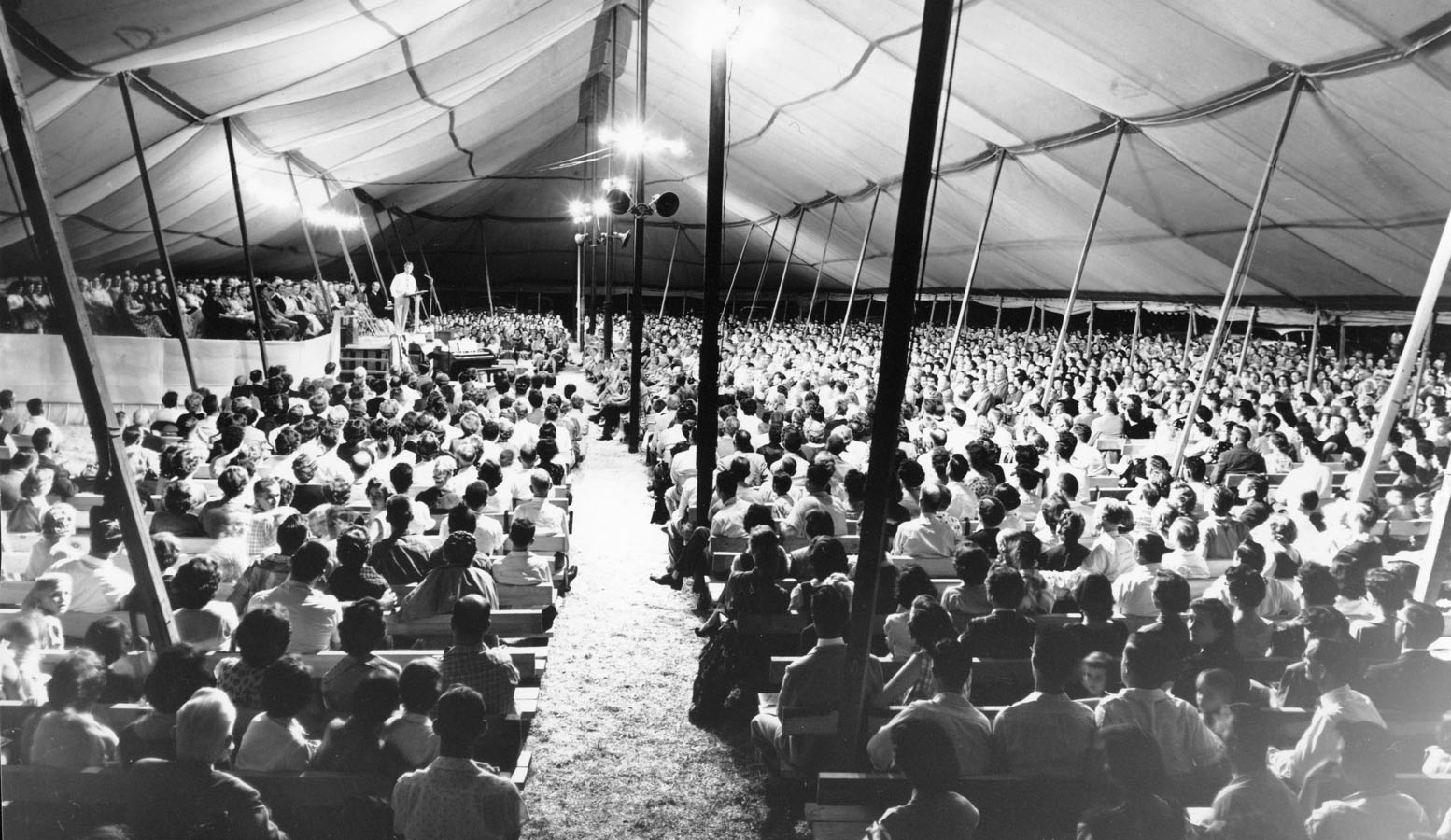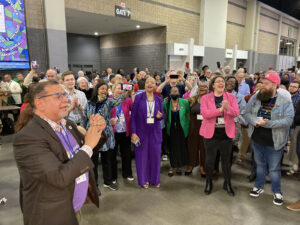
NASHVILLE, Tenn. (BP)–A unique personal collection of correspondence, promotional materials, sermons, photographs, motion pictures and audio and video recordings from the ministry of the late Southern Baptist evangelist Eddie Martin, one of the most popular and successful evangelists in the 20th century, has recently opened at the Southern Baptist Historical Library and Archives.
“This collection is significant for us because we don’t have anything else like it,” said Bill Sumners, director of the library and archives, located in Nashville, Tenn. “It tells a story about a segment of Southern Baptist life, of what revival means, of what city-wide crusades meant. This collection is so good because it documents an element of Baptist life not just in text format but visually through photographs, motion picture film and recordings.”
The papers span the period from 1938 to 1997 and represent more than 50 years of Martin’s evangelistic ministry both in the United States and South America. The collection contains hundreds of photographs and recordings in different formats, from paper and Mylar tape to reel-to-reel tape and audiocassette, 16mm film and videocassette tape, said Howard Gallimore, archival assistant at the library and archives. The photographs illustrate the crusades, revivals and soul-winning campaigns conducted by Martin primarily in the South and Southwest, and the film and sound recordings illuminate the holdings with action and sound from the great crusades conducted in assembly halls, football fields, stadiums and tents.
Martin was born in Lancaster, Pa., in 1915 to a non-Christian family. When a woman visited the home and shared the gospel message, Martin’s mother accepted Christ but the rest of the family refused. After some time, everyone but Martin followed the mother’s lead.
As a rebellious teenager, Martin showed no interest in Christianity though his mother faithfully prayed for his salvation and left gospel tracts for him in inconspicuous places such as under his pillow or cereal bowl. Finally, at about age 16, the tracts caused Martin to consider his sinful, lost condition and make a change in his life by professing faith in Christ.
After graduating from high school, Martin became a successful businessman in the rock wool industry. As Gallimore explained, rock wool was pumped into walls and used as insulation in buildings before the more modern form of insulation was used.
In his early 20s, Martin heard a message from evangelist Porter Barrington and knew God was calling him to become an evangelist as well. Martin attended the Moody Bible Institute in Chicago in the late 1930s, and there he read a biography of D.L. Moody that touched him in a crucial way.
Martin read that Moody would not go to bed at night until he had shared the gospel with at least one lost person that day. Martin decided to make a similar commitment but to increase the number to three lost people per day. Throughout his ministry, Martin would credit his practice of personal evangelism with keeping him constantly focused on the needs of lost souls. During every crusade and revival he preached, he devoted the hours from 4 p.m. until the time of the service, usually 7 p.m., to personal visitation and soul-winning.
Gallimore described Martin as a handsome, athletic man who made a good first impression because of his striking dress and demeanor as a businessman. He was able to use those characteristics as an evangelist to draw crowds and capture attention. Martin employed an interesting method at the beginning of his ministry to get himself introduced as an evangelist. He asked his fellow classmates to write to their home pastors and tell them that the most promising Christian evangelist was available to lead a revival in their church. As a result, he received more invitations than he could fill.
Martin became associated with the Pocket Testament League of New York City in the early 1940s. He soon formed an evangelistic team in which a girls’ trio and a piano player or other musician would entertain and then he would preach and distribute pocket New Testaments. Along the way, he developed ministry techniques such as magic shows and chalk drawings to illustrate Bible stories. One of the notable draws was a tent that would seat 3,000, and it often overflowed.
“One of my favorite parts of the collection is a color 16mm film of how to take down the big tent,” Sumners said.
Martin packed coliseums and stadiums and spoke to football teams, in schools, prisons and factories and at coal mining sites. During World War II he spoke to black Army regiments when others overlooked them.
“He was a hard worker for evangelism,” Gallimore said of Martin. “He was a showman and would employ any technique he could find to get people’s attention. He was very animated.”
Known as the “Soul-Winning Evangelist,” Martin worked with more than 1,250 pastors in 1,500 crusades across the United States and published a widely used four-booklet evangelistic series called “The Law of the Harvest.”
In a 1992 compilation of letters presented to Martin from leaders in the Southern Baptist Convention and around the world, W.A. Criswell of First Baptist Church, Dallas, wrote, “No one in this living earth has been more blessed of God in soul-winning than have you. I cannot remember when you were not God’s anointed servant pleading with men and families to give their hearts and lives to the Lord Jesus.”
During the 1960s, Martin developed an interest in South America, particularly El Salvador. Gallimore said Martin once mentioned to someone that people in the United States had become disinterested in the gospel, so he was taking it elsewhere. He made many trips to El Salvador to lead revivals and evangelistic meetings. Through the Eddie Martin Evangelistic Association and his own personal funds, he established and supported churches and preaching stations and built churches, schools and houses for pastors in El Salvador.
Martin died of cancer in 1997 at age 81 at his home in Lancaster, Pa. Not long after, the Eddie Martin Papers were given to the Southern Baptist Historical Library and Archives by his widow, Evelyn Martin. Sumners said significant time was needed for the archivists to inventory the collection and make it available to the public.
“His collection was the hardest for us to develop of any I have worked on because he wrote on scraps,” Gallimore noted. “He wrote on napkins at the dinner table, he wrote on ticket stubs from airlines. The worst one was he wrote on a plastic bag in a motel that you put your dry cleaning in and send it out. He wrote on shirt cards. And he didn’t say the title is this, the date is this and so forth, he just started writing his sermons.”
Something else that makes the collection so valuable, Sumners said, is that Martin collected sermons on tape from other noted evangelists such as Criswell, R.G. Lee, Billy Graham, Freddie Gage and Gypsie Smith.
“We might not have those sermons otherwise,” Sumners said.
The extensive photographs tell a visual story of what revivals used to mean when city-wide crusades would last for weeks and many would be saved, Sumners said. Other collections may tell the story textually, but to tell it visually is something unique.
The inventory of the Eddie Martin Papers is available online at http://www.sbhla.org/downloads/809.pdf. The collection is open to anyone and may be viewed at the historical library and archives in the Southern Baptist Convention building in Nashville.
–30–
(BP) photos posted in the BP Photo Library at http://www.bpnews.net. Photo titles: BIG TENT REVIVAL, SPEAKING TO COAL MINERS, A GOSPEL FOR ALL RACES, JESUS IS THE WAY and WHATEVER IT TAKES.
















